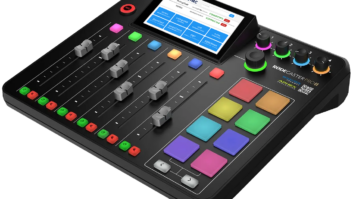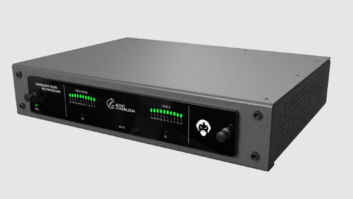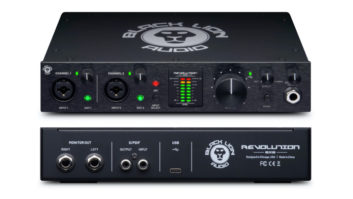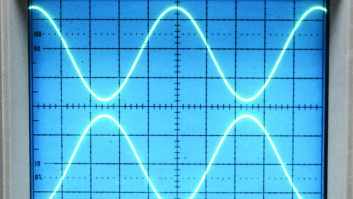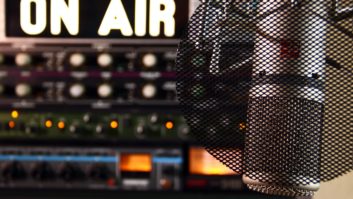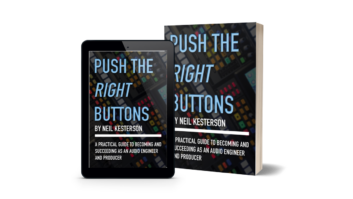BRUSSELS —Nine years after the Belgian Dutch-language public broadcaster VRT decided to launch a digitization and archiving project, the massive transfer of audio-visual content is entering the final stage.
By 2019, some 38,000 lacquer and shellac record sides will be digitized and stored for use and future reference.

Pictured in the VRT studios are (L to R) Koen Renders, media manager music archives, VRT; Anouck Gauvain, audio engineer, Gecko; Emiliano Flores, project leader, Gecko; Ben Vanderweyden, audio engineer, VRT; Klaas Janssens, audio engineer, VRT; and Jean-Baptiste Meunier, CEO, Gecko.

Christine Fettweis cleaning the surface of a disc.
THE BEGINNING
In 2008, the VRT initiated several projects to ensure the digital safeguarding and archiving of its massive sound and image library.
Then in 2012, the government launched Vlaams Instituut voor Archivering (VIAA), an organization taking on the sustainable archiving and access of all Flemish audio-visual heritage content.
“Whereas VRT’s projects focus on the public broadcaster’s audiovisual archives, VIAA takes a broader approach, archiving all of the audiovisual content within the collections of public broadcasters, heritage libraries, museums, archives and performing arts organizations,” explained Brecht Declercq, Digitization and Acquisition manager with VIAA. “VIAA acts as coordinator for the entire digitization strategy of audiovisual heritage in Flanders and manages the financing (with government subsidies).”
With efficient archiving and access being key, VRT opted for a central music archive management system, manufactured by Austrian archiving specialists, NOA. The NOA mediARC system includes the mediARC web function, which serves a few hundred users, MediaButler transcoding and the NOA IngestLine CD Lector migration device.

A lacquer disc is played on one of VRT’s vintage EMT 921 record players equipped with a dedicated stylus.

Operators wash a lacquer disc with ammonia.
CENTRAL MUSIC ARCHIVE
Christine Fettweis, head of VRT’s Music Library and Documentation department, adds that from day one, the NOA system has offered great results and has been key in the VRT’s evolution toward a centrally managed music service, whereas in the past each channel had its own audio library.
A team of 18 people continuously adds metadata to the music tracks for users’ reference, and performs maintenance on the NOA front end user interface.
“NOA Mediarc is a user-friendly, central system that allows direct access to all VRT workers,” said Fettweis. “The big advantage is we can now import audio content into our Dalet+ and MusicMaster playout systems, and that the full catalog can be consulted by staff working remotely. VRT has completed the digital archiving of its audio and Betamax cassettes, DAT tapes and CDRs and, as of press time, had nearly finished the file transfer of its 1/4-inch audio tapes. The next big chapter in VRT’s digitization process is the restoration, digitization and archiving of some 6,000 self-recorded lacquer discs, plus another 11,000 commercial shellac discs, mainly containing Belgian music.
Because transport of these fragile items is not easy and very expensive, VIAA, together with VRT, decided to keep them in-house instead of shipping them to an external digitization service provider.

Each side of every record is washed with osmosis water, ammonia, nonalcohol-based detergent or lamp oil and, if necessary, repaired with additional wax or glue.
UNUSUAL APPROACH
Normally, VIAA picks up audiovisual media at VRT (or another broadcaster) and groups them in batches for shipment to specialized external digitization companies.
“In this exceptional case, we agreed to do the digitization at VRT’s headquarters, and for a significant part, by VRT engineers,” said Declercq. “The public broadcaster has both equipment and expertise in-house to digitize part of these records themselves.”
The massive lacquer and shellac content supplied by the VRT and Flemish heritage institutions, which add up to about 38,000 record sides, urged VIAA to open a tender bid for a third partner. This company had to agree to transfer part of its staff, digitization and archiving equipment to VRT’s studios and to work with VRT operators,” Declercq explained.
“Via a European tender, we appointed French company Gecko, specializing in the digitization of records, tapes and audio cassettes. Gecko will digitize 11,000 commercial discs from VRT’s vaults as well as and approximately 3,000 disc sides from other heritage institutions.”

A disc ready for playback.
OPTIMAL CURVE
VRT’s specialized engineers are focusing on the lacquer discs. It is a quite labor-intensive process, as every record is individually checked and then washed with osmosis water, ammonia, a nonalcohol-based detergent or lamp oil and if necessary repaired with additional wax or glue.
“One of the challenges was to find the best suitable stylus,” explains Klaas Janssens, sound engineer of VRT’s Music Library and Archiving department. “The VRT ordered a number of needles from Expert Stylus, a U.K.-based manufacturer of tailor-made needles. Today we have styli for records going back as far as 1934.” VRT still plays the records on its own vintage EMT 921 phonograph players.
The next step for VRT was to implement the most suitable frequency correction curve on the records. “Before the RIAA standard, every record company used its own optimal curve to cut the record. We had to decide on a frequency curve, which had to be selected for each recording,” said Janssens.
“We use a Vadlyd MD12 MK4 Multicurve Disc preamp with a number of incorporated defined frequency curves and integrate digital plug-ins into the recording system. We make a simultaneous double recording of each record: a flat signal recording with the original content and a file with the curve we think is a best fit for the recording. The signal is then channelled through a Lynx Aurora eight-channel converter, which allows us to determine the version that results in the best modulation.”

The VRT’s stylus vault for the digitization project. A specific needle is available for each type of record.
The record files are stored in a WaveLab environment at a 24-bit/96 kHz rate — a reasonable quality according to Janssens, considering that that the recordings were made when dynamics and frequency characteristics were rather limited.
“Contrary to the other media types we digitized, we are repacking all discs that are in the realm of the project for heritage reasons. The heavily damaged or irreparable discs can wait for upcoming new technology, such as optical reading. The commercial discs are stored for legal (copyright) reasons,” explained Fettweis.
According to Declercq, the business model (collaboration of a public broadcaster and a commercial content digitization company, under the wings and management of VIAA) is catching international attention.
The digital audio content will be available for public radio broadcast and educational purposes, granting some 30,000 lecturers and student lecturers access to samples from this extensive library.
VIAA’s future plans are to set-up access points for scientific research and for the wider audience via public libraries. “Finding the right balance between making heritage content available to the public, the national broadcaster’s interests and the author’s rights legislation will be the next issue,” concluded Declercq.





